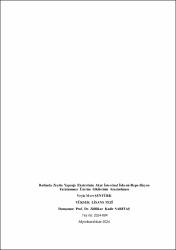Ratlarda zeytin yaprağı ekstretinin akut intestinal iskemi-reperfüzyon yaralanması üzerine etkilerinin araştırılması
Abstract
Ratlarda akut intestinal iskemi reperfüzyon hasarında zeytin yaprağı ekstretinin etkilerinin araştırılması konulu bu tez çalışmasında ratlarda akut intestinal iskemi reperfüzyon hasarında zeytin yaprağı ekstretinin etkinliği araştırmak ve gelecekte bu çalışmadan yararlanılarak zeytin yaprağı ekstretinin iskemi üzerine etkilerine ışık tutmaktır.
Bu çalışmada 250-300 gr aralığında bulunan Wistar cinsi erkek albino ratlar kullanıldı. Çalışmada her bir deney grubu 8 adet erkek rattan oluşacak şekilde rastgele 32 rat seçildi ve toplamda 4 grup olmak üzere (n=8) etik kurul onayı alındıktan sonra çalışmaya başlandı. Ratlar 12 saat aydınlık, 12 saat karanlık ortamda, standart kafeslerde ve aynı laboratuvarda barındırıldı. Ratlar çalışmaya başlandıktan sonra operasyondan öncesi 12 saate kadar ad libitum rat yemi verildi ve serbest biçimde su içmeleri sağlandı.
Gruplar; Kontrol, SHAM, IIR-200 ve IIR-400 olarak sınıflandırıldı. Kontrol grubunda yalnızca sağlıklı ratlar beslendi. SHAM grubundaki ratlarda yalnızca akut intestinal iskemi reperfüzyon hasarı oluşturuldu. IIR-200 grubundaki ratlara günde 1 defa toplamda 7 gün olacak şekilde oral gavaj ile 200 mg/kg dozunda zeytin yaprağı ekstreti verildikten sonra akut intestinal reperfüzyon hasarı oluşturuldu. IIR-400 grubundaki ratlara ise günde 1 defa, toplamda 7 gün olacak şekilde oral gavaj yoluyla 400 mg/kg dozunda zeytin yaprağı ekstreti içirildikten sonra akut intestinal iskemi reperfüzyon hasarı oluşturuldu.
SHAM, IIR-200 ve IIR-400 gruplarında derin anestezi altına abdomen steril şartlarda laparotomi için hazırlanarak, median laparatomi gerçekleştirilip, Arteria renalisin cranialinden arteria mezenterika cranialis bulldog klempler ile 30 dk süre ile oklüde edildi ve 30 dk sonunda klemp kaldırılarak 2 saat reperfüzyon gerçekleştirildi. 24. saatte olgular sakrifiye edildi. Sakrifiye edilen ratlardan ileum örneği toplandı. Sakrifikasyon işlemi yüksek doz anestezik ile gerçekleştirildi. Kan örnekleri kardiyak punksiyon ile alındı.
Alınan ileum örnekleri histopatolojik olarak incelendiğinde çıkan sonuçlar gruplarda sırasıyla 0,38±0,38, 2,75±0,16, 2,13±0,13, 0,50±0,19 olarak kaydedildi. Tüm gruplarda elde edilen bulgular istatistiksel olarak karşılaştırıldığında kontrol ve sham ile IIR-200 ve IIR-400 grupları arasında istatistiksel farklar olduğu belirlendi (P < 0.05)
Alınan kan örneklerinde ise hemogram değerlerine ve serumundan TAS, TOS, IL-1, IL-6, TNF-α, HYP, NO ölçümleri yapıldı. IIR-200 ve IIR-400 zeytin yaprağı ekstreti grubu SHAM ve kontrol grubuyla karşılaştırıldığında biyokimyasal olarak TAS IIR-400 grubunda daha yüksek düzeyde belirlenmiş olup IIR-200 grubunda daha düşük olduğu belirlenmiştir (P<0.05). Bununla birlikte proinmflamatuar sitokinler daha düşük düzeyde olduğu belirlenmiştir (P<0.05). HYP ise kontrol ve SHAM grubuyla IIR-400 grubu karşılaştırıldığında istatistiksel önemi olmamakla birlikte aritmetik olarak daha düşük seviyede belirlenmiştir (P>0.05). Yine NO için de SHAM grubuyla IIR-400 grubuyla kıyaslandığında daha düşük seviyede ölçülmüştür (P<0.05). Yapılan çalışmadaki verilerden yola çıkılarak zeytin yaprağı eksteretinin iskemi oluşumunu önlemede olumlu etkilerinin olduğu görülmüştür. In this thesis on the investigation of the effects of olive leaf extract on acute intestinal ischemia reperfusion injury in rats, the effectiveness of olive leaf extract on acute intestinal ischemia reperfusion injury in rats is investigated, the effects of olive leaf extract on preventing mesenteric ischemia injury are investigated, and this study is used in the future to shed light on the effects of olive leaf extract on ischemia.
Wistar male albino rats weighing between 250-300 g were used in this study. In the study, 32 rats were randomly selected, each experimental group consisting of 8 male rats, and the study was started after receiving ethics committee approval, 4 groups in total (n = 8). Rats were housed in a 12-hour light, 12-hour dark environment, in standard cages and in the same laboratory. After the rats started working, they were given ad libitum rat food and allowed to drink water freely for up to 12 hours before the operation.
Groups; They were classified as control, SHAM, IIR-200 and IIR-400. In the control group, only healthy rats were fed. Only acute intestinal ischemia reperfusion injury occurred in the rats in the SHAM group. Acute intestinal reperfusion injury was created after the rats in the IIR-200 group were given olive leaf extract at a dose of 200 mg/kg by oral gavage once a day for a total of 7 days. Acute intestinal ischemia reperfusion injury was caused to the rats in the IIR-400 group after they were given olive leaf extract at a dose of 400 mg/kg via oral gavage once a day for a total of 7 days.
In the SHAM, IIR-200 and IIR-400 groups, under deep anesthesia, the abdomen was prepared for laparotomy under sterile conditions, median laparotomy was performed, and the arteria mesenterica cranialis from the cranial arteria renalis was occluded with bulldog clamps for 30 minutes, and at the end of 30 minutes, the clamp was removed and reperfusion was performed for 2 hours. The cases were sacrificed at the 24th hour. Samples were collected from the ileum of sacrificed rats. The sacrification process was performed with high doses of anesthetic. Blood samples were taken by cardiac puncture.
When the ileum samples taken were examined histopathologically, the results were recorded as 0.38±0.38, 2.75±0.16, 2.13±0.13, 0.50±0.19 in the groups, respectively. When the findings obtained in all groups were compared statistically, it was determined that there were statistical differences between the control and sham and IIR-200 and IIR-400 groups (P < 0.05).
Hemogram values and serum TAS, TOS, IL-1, IL-6, TNF-α, HYP, NO were measured in the blood samples taken, when the IIR-200 and IIR-400 olive leaf extract groups were compared with the SHAM and control groups, TAS was biochemically determined to be higher in the IIR-400 group and lower in the IIR-200 group (P<0.05). However, proinflammatory cytokines were determined to be at lower levels (P<0.05). HYP, on the other hand, was determined to be arithmetically lower when comparing the control and SHAM groups with the IIR-400 group, although it did not have statistical significance (P>0.05). Again, NO was measured at lower levels in the SHAM group compared to the IIR-400 group (P<0.05). Based on the data in the study, it was seen that olive leaf extract had positive effects in preventing ischemia.
Collections
- Yüksek Lisans Tezleri [667]



















